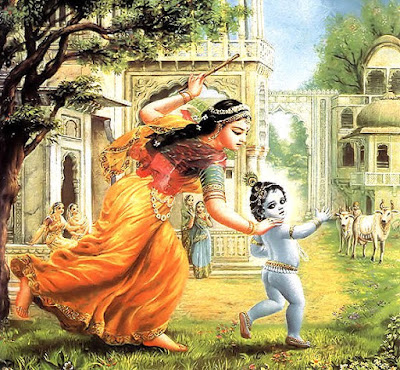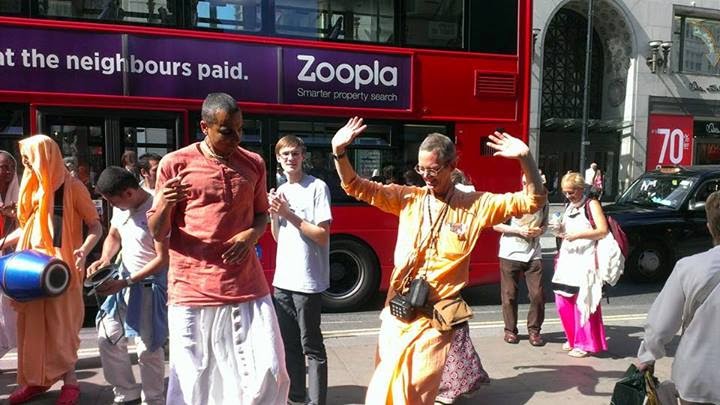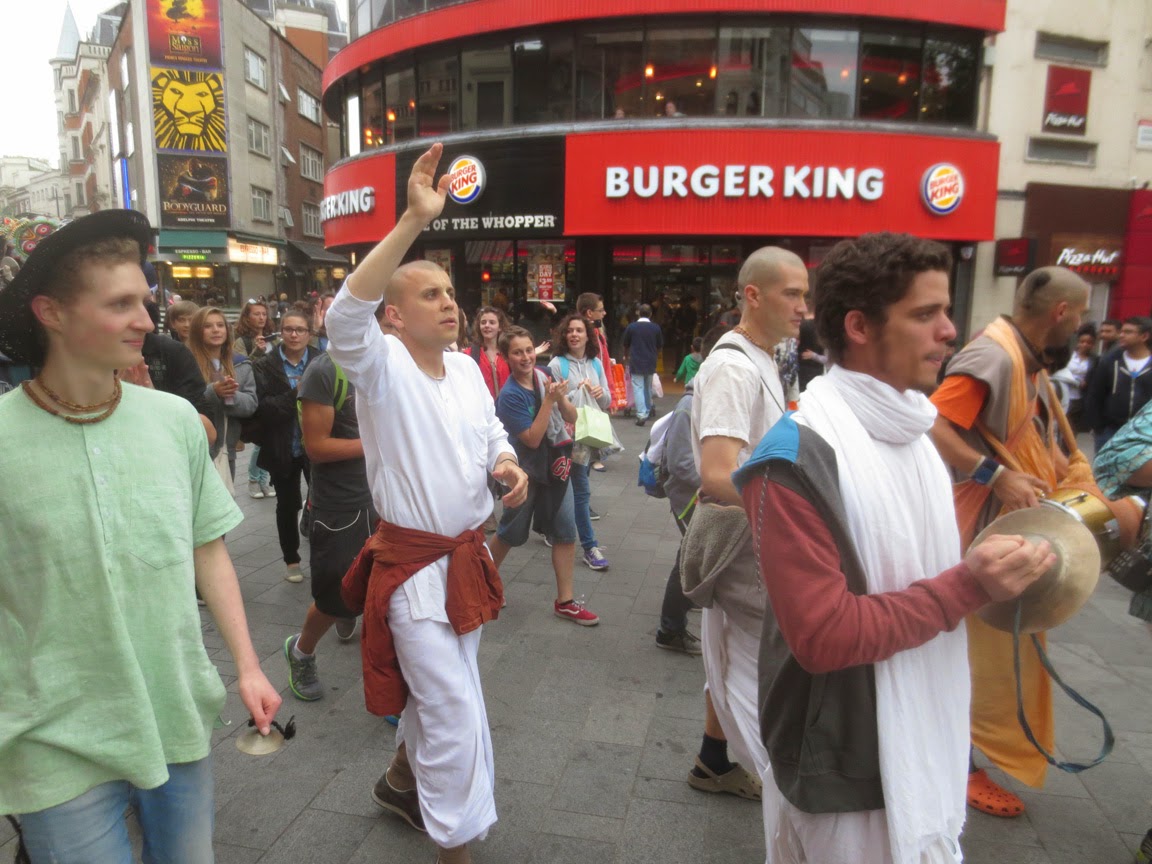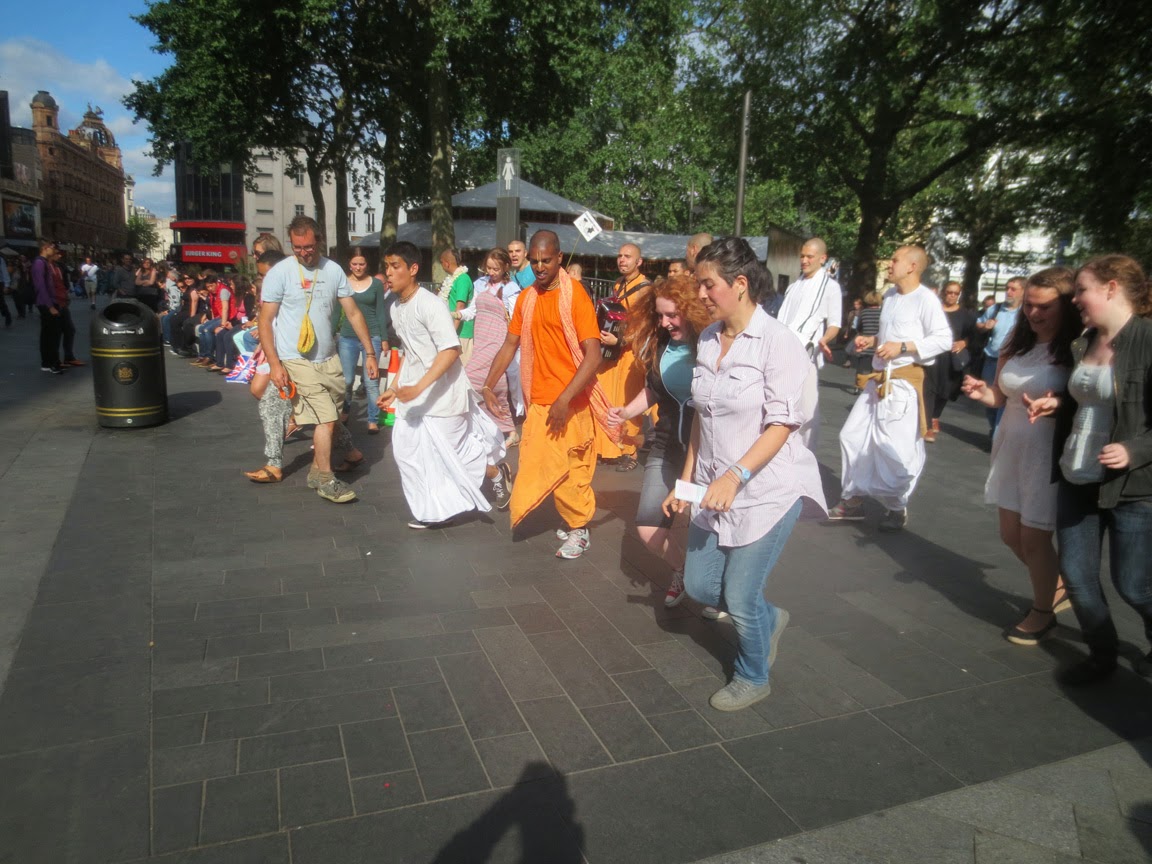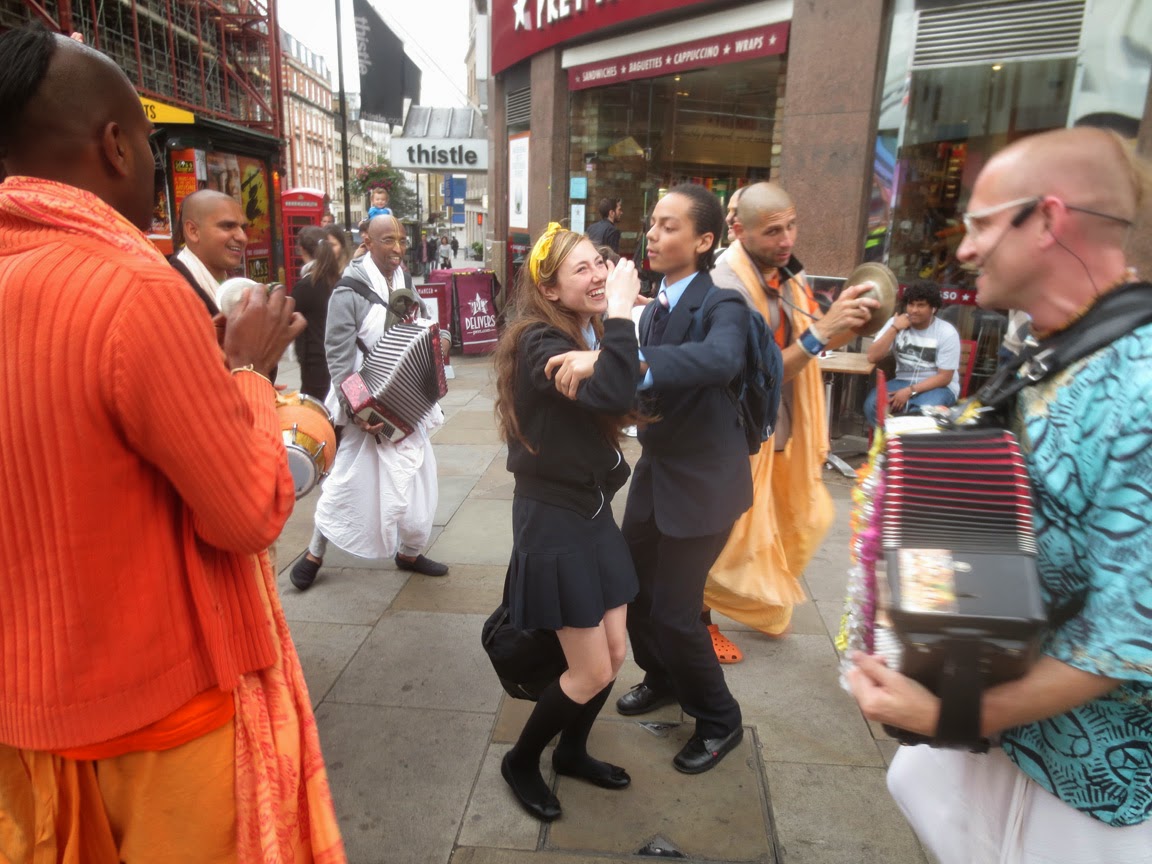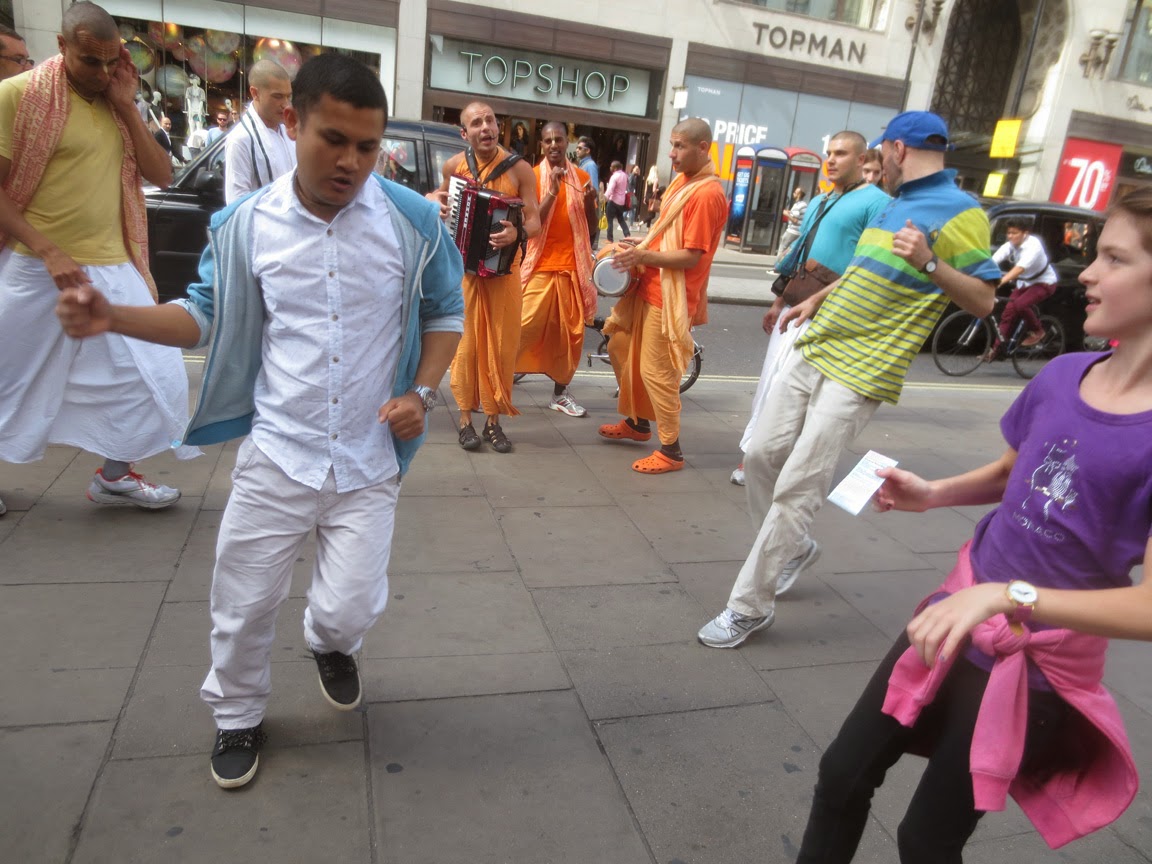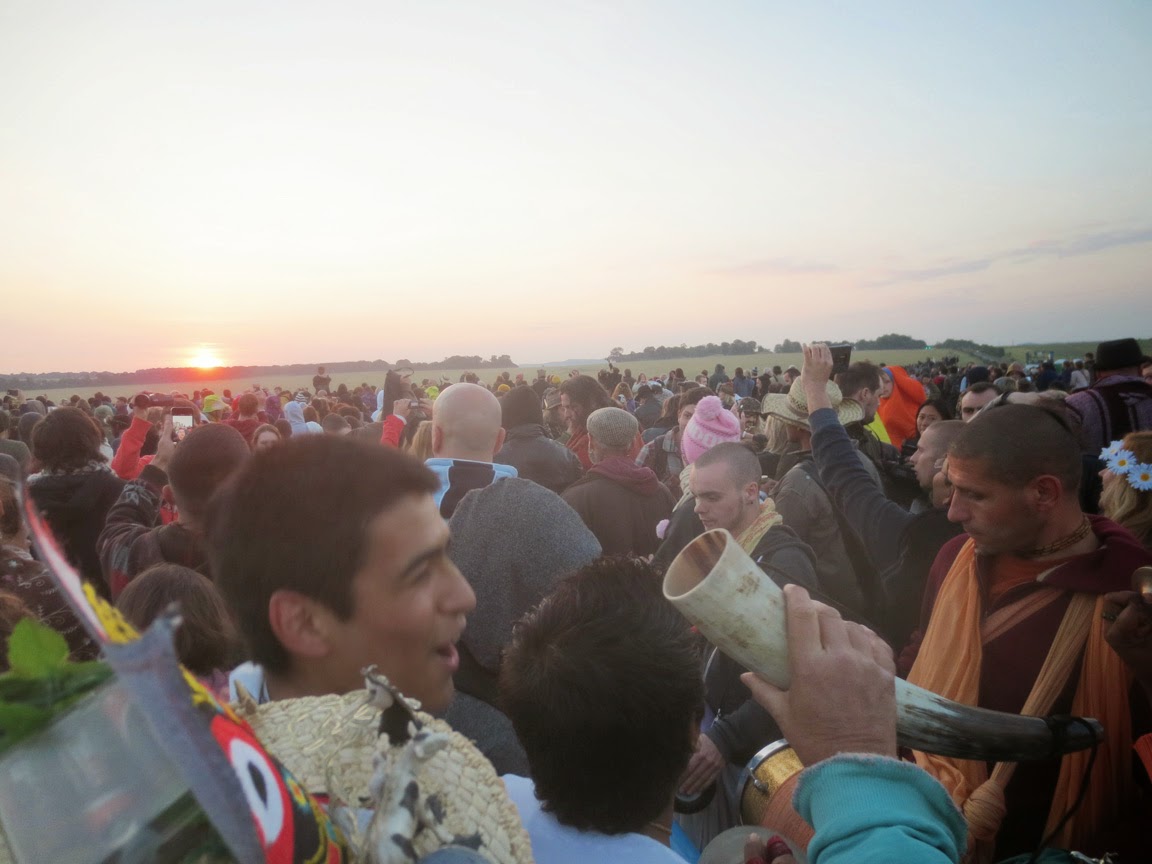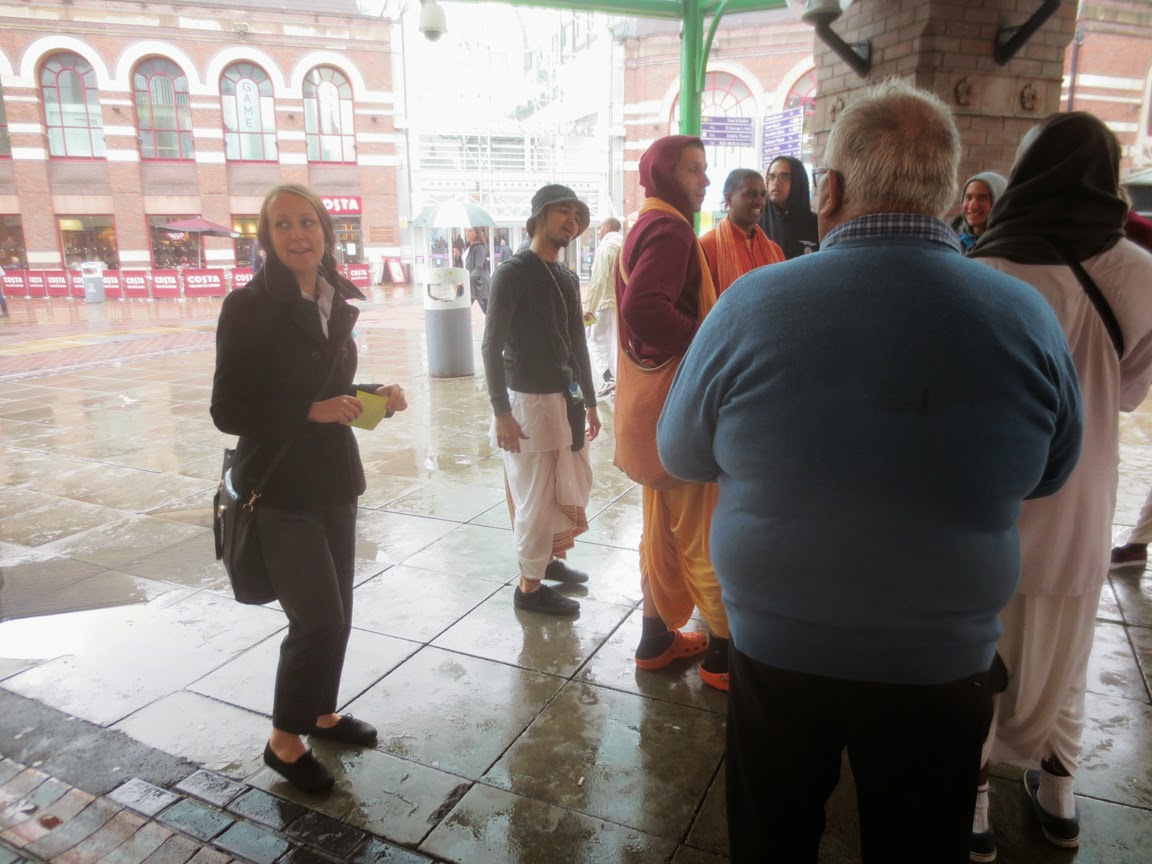If the suffering of great devotees is for their glorification why does Bhishma say Pandavas’ suffering is due to time?
When the Pandavas were so virtuous why did Krisha let them suffer so much?
→ The Spiritual Scientist
Why was Kunti’s unknowing statement ‘share whatever you have brought’ considered absolute and Draupadai married too all the Pandavas?
→ The Spiritual Scientist
Draupadi forgave Ashwatthama but not the Kauravas. Why?
→ The Spiritual Scientist
Extended Summer Gopinath’s Kids Camp – August 7 – 9, 2014!
→ The Toronto Hare Krishna Temple!
This year, the 8th Annual Gopinath's Kids Camp will be held from Thursday, August 7th to Saturday, August 9th from 9:00am - 5:00pm, strictly for kids aged 4-12 years. We are extending our annual one-day camp to a three-day camp and it will provide an opportunity to ignite the spiritual spark in our children while doing fun and interactive activities that they enjoy. In addition to outdoor games, some of the primary activities being planned for the day are a Mega Scavenger Hunt, fun cooking classes, learning how to play different musical instruments, sumptuous prasadam and many fond memories.
All this and much more for registration fees of only $25 per day or $60 for all three days! You can register at the temple or use our online form by clicking here (last day to register is August 5th). For further information, please don't hesitate to email us at kids@torontokrishna.com.
HG Narottamananda Prabhu / Kalachandji’s Bhagavad-Gītā Meditation Course – 30
→ Kalachandji's Audio Archive
HH Kesava Bharati Dasa Goswami / SB 10.66.15
→ Kalachandji's Audio Archive
HG Visvambhara Prabhu / SB 10.66.11
→ Kalachandji's Audio Archive
Dancing On Your Tongue
→ Japa Group
Forever young!
→ KKSBlog
(Kadamba Kanana Swami, 14 September 2013, Durban, South Coast Hall Program, Class “Living in truth”)
 I was reading a story where it is said that “Knowledge” and “Renunciation” had become very weak. They had become very depleted due to the influence of kali; they had become very old! Although they were young, they looked very weak and gray, as though they were eighty!
I was reading a story where it is said that “Knowledge” and “Renunciation” had become very weak. They had become very depleted due to the influence of kali; they had become very old! Although they were young, they looked very weak and gray, as though they were eighty!
It is said that their friends and relatives such as “Truthfulness”, “Tolerance” and “Wisdom”, were also very weak. “Friendship” was totally crippled, was seriously crippled. “Friendship” could barely walk; “Friendship” only existed on the basis of profit!
So gradually, in the age of kali, all these qualities became weak, but one quality somehow or other, was still youthful and that was BHAKTI! Bhakti still stood. Bhakti was unaffected. So after a long time of not having seen each other, Bhakti met “Renunciation” and it was like, “Renunciation, you are still alive!? I haven’t heard from you for so long! I thought you would have passed away by now. Oh, Renunciation, I heard you are not in good health.”
Then “Renunciation” said, “Bhakti, you haven’t changed at all: you are still ever-fresh. What happened? How come, my dear Bhakti, my dear devotional service? How come Bhakti has survived when all other qualities have become weakened…?”
Bhakti explained, “Because of this benediction: kalau tad dhari-kīrtanāt, because in this age of kali there is HARI-KIRTAN and this hari-kirtan is the nourishment of Bhakti, the nourishment of devotional service. It is the essence of devotional service. Actually, it is the most important activity within the realm of devotional service. Everything comes from that!”
So in this way, Bhakti knows the secret of youth. She looked as young and elevated than ever when all the others were weakened.
——————————————————-
kṛte yad dhyāyato viṣṇuḿ tretāyāḿ yajato makhaiḥ dvāpare paricaryāyāḿ kalau tad dhari-kīrtanāt
TRANSLATION: Whatever result was obtained in Satya-yuga by meditating on Viṣṇu, in Tretā-yuga by performing sacrifices, and in Dvāpara-yuga by serving the Lord’s lotus feet can be obtained in Kali-yuga simply by chanting the Hare Kṛṣṇa mahā-mantra. (Śrīmad Bhāgavatam 12.3.52)
Krishna Lounge Kirtan & Talk for July 17th 2014
→ Krishna Lounge

Kirtan lead by Mukunda:
Kirtan lead by Giriraj Gopal dasa:
Talk by Giriraj Gopal dasa:
Speaker of Lok Sabha Presented With Bhagavad-Gita
→ ISKCON News
Gita Nagari Retreat & Vyasa Puja (Album 80 photos)
→ Dandavats.com
 "I offer my respectful obeisances unto the Lotus Feet of my Spiritual Master and unto the feet of all Vaishnavas. I offer my respectful obeisances unto the Lotus Feet of Srila Rupa Gosvami along with his elder brother Sanatana Gosvami, as well as Raghunatha Dasa and Raghunatha Bhatta, Gopala Bhatta, and Srila Jiva Gosvami. I offer my respectful obeisances to Lord Krishna Chaitanya and Lord Nityananda along with Advaita Acharya, Gadadhara, Srivasa, and other associates. I offer my respectful obeisances to Srimati Radharani and Sri Krishna along with Their associates Sri Lalita and Vishakha." Read more ›
"I offer my respectful obeisances unto the Lotus Feet of my Spiritual Master and unto the feet of all Vaishnavas. I offer my respectful obeisances unto the Lotus Feet of Srila Rupa Gosvami along with his elder brother Sanatana Gosvami, as well as Raghunatha Dasa and Raghunatha Bhatta, Gopala Bhatta, and Srila Jiva Gosvami. I offer my respectful obeisances to Lord Krishna Chaitanya and Lord Nityananda along with Advaita Acharya, Gadadhara, Srivasa, and other associates. I offer my respectful obeisances to Srimati Radharani and Sri Krishna along with Their associates Sri Lalita and Vishakha." Read more › Travel Journal#10.12: London, Stonehenge, Nottingham, and The North of England
→ Travel Adventures of a Krishna Monk
By Krishna-kripa das
(June 2014, part two)
(Sent from Kostrzyn, Poland, on July 29, 2014)
Jake, on the extreme left of the above picture, who has been coming to our programs in Newcastle for a year of so, stayed an extra few days after Ratha-yatra and came on harinama.
There were many, many people who danced, chanted, and smiled, encountering our harinama party in London.
It was the first time it was clear enough you could actually see the sun rise, and I think that put everyone in a good mood.
We did it from 1:00 to 3:00 a.m. in the morning! I think it is the only Ratha-yatra performed at the time of day, or rather, that time of night.
People are attracted by the opportunity to pull the Jagannatha cart, although often they are a bit intoxicated.
“Yes,” I replied smiling, “it is all good.” And I recalled Rupa Goswami saying, “Pure devotional service is the beginning of all auspiciousness.” It was wonderful that an apparently ordinary guy could glimpse the truth that Krishna consciousness is all good, or as it is described in the Sanskrit literature, suddha-sattva, pure goodness.
One young man pushing the steel railing of the Ratha cart said, “This is the best steel I have ever touched!”
I went to give her my card, saying I could tell her about all our festivals in the UK, but she said she still had my card from Rishikesh.
In Leeds we chanted in a natural cosmetics shop, and all the employees were happy we were there.
Dayananda Swami, who was visiting York for some North UK meetings, joined us.
Some girls took pleasure in dancing to our music two and possibly even three times. We also encountered a natural cosmetic shop in York, and all three employees loved the kirtana, and they also danced around in a circle (https://www.youtube.com/watch?v=WyvAONyGwuE).
July 29th, 2014 – Darshan
→ Mayapur.com
The post July 29th, 2014 – Darshan appeared first on Mayapur.com.
Kirtan Course with a virtual pilgrimage to the samadhi tomb of Bhaktivinoda Thakur (Album 60 photos)
→ Dandavats.com
 This week the Kirtan course students are over half way through their course and they had a special visiting teacher in the form of Jahnavi Harrison who took the students through reading and singing the Saranagati prayers of Bhaktivinoda Thakura.
The students discovered songs from the 6 sections of the Saranagati:
1) Humility
2) Surrender
3) Accepting the Lord as one's maintainer
4) Considering the Lord to be one's protector in all circumstances
5) Accepting those things that are favourable for devotional service
6) Rejecting those things that are unfavourable to devotional service
The week's objectives were to:
1) Connect with the author by reading extracts from The Seventh Goswami by Rupa Vilasa dasa
2) Connect with the songs
3) Feel comfortable reading in Bengali
4) Discover how the songs enhance the maha mantra
To conclude the week they took a virtual pilgrimage to the samadhi tomb of Bhaktivinoda Thakur, via film footage, and wrote individual prayers of gratitude to offer to him. Each student received a packet with some small chips of his samadhi stone (after renovations), some dust from the floor of his chanting room, and twigs from the birthplace of Lord Caitanya.
Towards the end of the week, the students were given a short class by HH Lokanatha Maharaja who extolled the importance of proper sanskrit pronunciation when singing.
Then, the weekend brought the Radhadesh summer festival where the sun shone brightly and students were very much involved in the festivities - from throwing themselves into the Holi arena and being showered in colour to stepping onto stage with HH Lokanatha Swami and HH Kadamba Kanana Swami to presenting on stage what they'd been learning so far... Read more ›
This week the Kirtan course students are over half way through their course and they had a special visiting teacher in the form of Jahnavi Harrison who took the students through reading and singing the Saranagati prayers of Bhaktivinoda Thakura.
The students discovered songs from the 6 sections of the Saranagati:
1) Humility
2) Surrender
3) Accepting the Lord as one's maintainer
4) Considering the Lord to be one's protector in all circumstances
5) Accepting those things that are favourable for devotional service
6) Rejecting those things that are unfavourable to devotional service
The week's objectives were to:
1) Connect with the author by reading extracts from The Seventh Goswami by Rupa Vilasa dasa
2) Connect with the songs
3) Feel comfortable reading in Bengali
4) Discover how the songs enhance the maha mantra
To conclude the week they took a virtual pilgrimage to the samadhi tomb of Bhaktivinoda Thakur, via film footage, and wrote individual prayers of gratitude to offer to him. Each student received a packet with some small chips of his samadhi stone (after renovations), some dust from the floor of his chanting room, and twigs from the birthplace of Lord Caitanya.
Towards the end of the week, the students were given a short class by HH Lokanatha Maharaja who extolled the importance of proper sanskrit pronunciation when singing.
Then, the weekend brought the Radhadesh summer festival where the sun shone brightly and students were very much involved in the festivities - from throwing themselves into the Holi arena and being showered in colour to stepping onto stage with HH Lokanatha Swami and HH Kadamba Kanana Swami to presenting on stage what they'd been learning so far... Read more › Gita Nagari Ratha Yatra 2014 (Album 39 photos)
→ Dandavats.com
 As a fire burns dry grass to ashes, so the holy name of the Lord, whether chanted knowingly or unknowingly, burns to ashes, without fail, all the reactions of one's sinful activities. SB 6.2.18 Read more ›
As a fire burns dry grass to ashes, so the holy name of the Lord, whether chanted knowingly or unknowingly, burns to ashes, without fail, all the reactions of one's sinful activities. SB 6.2.18 Read more › Ratha Yatras Meaning
→ HH Bhakti Caitanya Swami
Balarama asks what color is the brahmajyoti
→ SivaramaSwami.com
Supriya d.d. about bad luck with bad vastu and Gaura Nita d. a string of questions including why are bulls castrated.
The post Balarama asks what color is the brahmajyoti appeared first on SivaramaSwami.com.
Your prayers for Govardhana Hill on Balaram’s Purnima. August 10th
→ Dandavats.com
 The area of Radha Kunda, Shyama Kunda and Govardhan Hill is the topmost holy place in the universe. It has been recorded that about 10 million people visit Govardhana on Guru Purnima day alone. Education and trash cans are only the tip of the iceberg when it comes to what it will take to keep this holy place clean. To match the cleanliness and beauty standards of New York City’s Central Park, we will need a small army of sanitation workers, tree care experts, gardeners, drivers, park rangers, and more, all taking care of Govardhana. Right now we have about 30 local brajavasi’s (mostly widows) working to keep a few areas in Radha Kunda clean. Wouldn’t it be wonderful to see 2,500 people working to keep all of Govardhana area clean, beautiful, and organized in many different departments, including relief for the poor and elderly? We don’t need to control the government. We just need to organize the care of Govardhana.
Are we His servants, or is He ours? Read more ›
The area of Radha Kunda, Shyama Kunda and Govardhan Hill is the topmost holy place in the universe. It has been recorded that about 10 million people visit Govardhana on Guru Purnima day alone. Education and trash cans are only the tip of the iceberg when it comes to what it will take to keep this holy place clean. To match the cleanliness and beauty standards of New York City’s Central Park, we will need a small army of sanitation workers, tree care experts, gardeners, drivers, park rangers, and more, all taking care of Govardhana. Right now we have about 30 local brajavasi’s (mostly widows) working to keep a few areas in Radha Kunda clean. Wouldn’t it be wonderful to see 2,500 people working to keep all of Govardhana area clean, beautiful, and organized in many different departments, including relief for the poor and elderly? We don’t need to control the government. We just need to organize the care of Govardhana.
Are we His servants, or is He ours? Read more › Birmingham Rathayatra 2014 (Album 64 photos)
→ Dandavats.com
 Living beings who are entangled in the complicated meshes of birth and death can be freed immediately by even unconsciously chanting the holy name of Krishna, which is feared by fear personified. SB 1.1.14 Read more ›
Living beings who are entangled in the complicated meshes of birth and death can be freed immediately by even unconsciously chanting the holy name of Krishna, which is feared by fear personified. SB 1.1.14 Read more › Nimai School at Umuebulu 2, Etche LGA (Nigeria) celebrates End Of Academic Year
→ Dandavats.com
 The event which took place in the temple premises at Umuebulu 2, Etche LGA (Nigeria) saw people from all walks of life. Including devotees from far and near trooped in to the premises to have a glance of the young pupils. The father of the day, Prabhu Hariha Das, appreciated the teachers and the school committee for instilling Krishna consciousness into the young ones despite the fact that most of them are children of non-devotees. In the same vein, the Chair lady of the occasion, mother Kapasuni Devi Dasi, encouraged the children never to forget Krishna conscious activities and always be studious even as they go on long vacations. Also speaking was the master of ceremony (MC) Prabhu Bhadra Das, who commended the children and the teachers for a good job. Read more ›
The event which took place in the temple premises at Umuebulu 2, Etche LGA (Nigeria) saw people from all walks of life. Including devotees from far and near trooped in to the premises to have a glance of the young pupils. The father of the day, Prabhu Hariha Das, appreciated the teachers and the school committee for instilling Krishna consciousness into the young ones despite the fact that most of them are children of non-devotees. In the same vein, the Chair lady of the occasion, mother Kapasuni Devi Dasi, encouraged the children never to forget Krishna conscious activities and always be studious even as they go on long vacations. Also speaking was the master of ceremony (MC) Prabhu Bhadra Das, who commended the children and the teachers for a good job. Read more › Sunday Harinama in New York City, USA (Album 17 photos)
→ Dandavats.com
 My dear King, although Kali-yuga is an ocean of faults, there is still one good quality about this age: Simply by chanting the Hare Krishna maha-mantra, one can become free from material bondage and be promoted to the transcendental kingdom. SB 12.3.51 Read more ›
My dear King, although Kali-yuga is an ocean of faults, there is still one good quality about this age: Simply by chanting the Hare Krishna maha-mantra, one can become free from material bondage and be promoted to the transcendental kingdom. SB 12.3.51 Read more › Sanskrit thriving in British schools! (3 min video)
→ Dandavats.com
 At the St James Junior School in London, the number of students wanting to learn the language has grown by leaps and bounds. Read more ›
At the St James Junior School in London, the number of students wanting to learn the language has grown by leaps and bounds. Read more › I lost my heart in the Vaishnava Baltic Summer Festival 2014 (Album 310 photos)
→ Dandavats.com
 Simply because I chanted the holy name of the Lord in the association of devotees, my heart is now becoming purified. Therefore I shall not fall victim again to the false lures of material sense gratification. Now that I have become fixed in the Absolute Truth, henceforward I shall not identify myself with the body. I shall give up false conceptions of "I" and "mine" and fix my mind on the lotus feet of Krishna. SB 6.2.38 Read more ›
Simply because I chanted the holy name of the Lord in the association of devotees, my heart is now becoming purified. Therefore I shall not fall victim again to the false lures of material sense gratification. Now that I have become fixed in the Absolute Truth, henceforward I shall not identify myself with the body. I shall give up false conceptions of "I" and "mine" and fix my mind on the lotus feet of Krishna. SB 6.2.38 Read more › Why did Krishna and Arjuna meet each other first time so late in their lives?
→ The Spiritual Scientist
Shayan Darshan of Sri Sri Radha Gopinath;25th July 2014
→ Gouranga TV - The Hare Krishna video collection
Shayan Darshan of Sri Sri Radha Gopinath;25th July 2014
Why did Balaramji favour Duryodhana?
→ The Spiritual Scientist
Arjuna’s virtuous victory – Don’t challenge God’s wisdom; let God’s wisdom challenge you – 2
→ The Spiritual Scientist
When different religious groups have their own scriptures how is the authority of Vaishnava scriptures to be established?
→ The Spiritual Scientist
Is the expansion of the Mahabharata from its short Jaya version a contamination?
→ The Spiritual Scientist
What guided humanity before scripture was written?
→ The Spiritual Scientist
Arjuna’s virtuous victory – Don’t challenge God’s wisdom; let God’s wisdom challenge you – 1
→ The Spiritual Scientist
Mahabharata characters 71 Ashwatthama The dangerous temptation to punish
→ The Spiritual Scientist
This talk is a part of the "Fascinating Mahabharata Characters" series. To know more about this course, please visit: bhakticourses.com
Is the Mahabharata contaminated due to interpolation?
→ The Spiritual Scientist
Saturday, July 26th, 2014
→ The Walking Monk
The Last
The last of the stops for the festival tour culminated in Edmonton. The sky had been insistent on bucketing the water. By noon, the dumping of yesterday converted to a spray which eventually depleted as our outdoor procession of the Chariot Festival was in progress.
As remarked by more than one person, there was a remarkable focus on chanting and dancing. The location or route was a little odd – through an industrial plaza strip area. Perhaps it will take a little more time for us to prepare ourselves for hip Whyte Avenue for the future.
One instance that pulled out of the sternness in me, and then later a chuckle, had to do with one of our young bus troupers. Young Raj is from Texas. He was in the procession like the rest of us. He managed to grab a plate of prasad (sanctified food) and had a nibble at it. Where one of the escorted police cars was parked along the way, Raj decided to place his food on the front hood of the car as he was fiddling with something. The police officer was making his way back to his vehicle when I noticed the plate on the car. I conveniently had a mic in my hand since I was the person responding to the lead singer in the procession. I used the mic to alert Raj, I beckoned him towards me, “Raj!” who then picked up the plate and came to me. I gave him a mild chiding and said, “You should never do that. You don’t want to be disrespectful, do you?” indicating that the police are our friends and are there to help us.
In innocence he said, “You mean I shouldn’t disrespect the prasad?”
“No, Raj, the police.”
Anyway, when it came to my few minutes on the stage once the chariot procession was over, I relayed the story to the crowd sitting before me. They also had a good laugh.
Our day ended with an hour long chanting session on Whyte Avenue where the evening young folks hang out. Kish, of the Mayapuris, lead the chant which had the support of three booming mrdanga drums. I personally like the percussion, it gets people hopping.
May the Source be with you!
7 KM
Friday, July 25th, 2014
→ The Walking Monk
A Monk’s Take on Family and Kids
“I would just like to see wholesome families become a part of the social fabric.” This I expressed to a young devotee of Krishna who’s engaged to be married.
It was the second time today that I had a conversation on the topic of marriage. “New world with old values,” were our mutual thoughts. “Many new experiments aren’t working,” said the thoughtful young man, without elaborating.
Then I offered to say, “Chosen life partners must be good listeners towards each other.”
A second person whom I would deem as successful in his marriage of several years, told of a third child on the way, and that I played a major role in what will soon be a new arrival. He explained that in my last visit I said something about how a good couple should consider many children. “It would increase a finer percentage of humans,” that was the logic. We know that is not always the case, yet my observation tells that dharmic couples can help the world with their procreation.
This second person, also a pious person, asked me frankly, “What do you, a monk, think of people like me, a married man, caught up in the world of money?”
I was frank, “You’re doing great.” I indicated, “Let’s populate the world with great offspring, kids with a good sense of right and wrong and who have a good drive.” We rambled on as rain and wind continued to be a lame excuse for not trekking today.
May the Source be with you!
0 KM
Thursday, July 24th, 2014
→ The Walking Monk
Water
A herd of elk came into our purview, while ground squirrels (black tail prairie dog) poked their heads out of their holes, mostly to see what we could offer them in the form of food. These creatures kept us company at the Marmot Meadows Campsite. We also caught glimpse of a black bear who entertained tourists simply by his very presence. European tourists just go nuts when they see Canadian wildlife, but they’re not the only ones. Canadian city slickers also go into a frenzy clicking their cameras.
It really was a day of wetness. The boys tents and their contents; cots, blankets, pillows, clothes, got drenched. It warranted a trip to the laundry mat. The place was already full, but with our entrance, 25 or so wild young folks, I’m the oldest, the place was completely packed.
In general, on a day of rain, or whether it be high winds, Indra dynamics becomes a reality. Still, water was not enough to intimidate. The big draw or attraction for the day for our bus crew was a swim and Radium Hot Springs, surprisingly done inside. By day’s end my legs became antsy for something outdoor. For a challenge I took to the downward road from mountain high down to the direction of Yellowhead Highway. There in raingear I tread, dodging the hefty currents of water coming down as rivulets on the asphalt.
I took these waves of downward water as a tax by maya, illusion. I was most alert, yet anything to avoid wet socks. Surely my chanting was evermore sharp as opposed to the more casual approach taken when sitting on the front seat of our bus. A small ounce of austerity or inconvenience imposed on the self always goes a long way to contributing to the life of a monastic. It happens to occur right here on the road, once again.
May the Source be with you!
6 KM
Wednesday, July 23rd, 2014
→ The Walking Monk
Mountainous Beauty
I covered a mere few kilometres on foot before the trip to Jasper, with stops along the way to capture with the eyes, the mountainous beauty. My hosts, Radha Madhava, Swasti, and daughters in Calgary, and I, drove along Highway 93. Any stops made along the way, whether washroom breaks or gassing up, gave me the opportunity to add a kilometre here and there.
One tourist pulled over and offered a ride wondering how I mystically moved so swiftly as he passed me by twice before. He just got so curious.
At Athabasca River we ventured down a trail as did so many other tourists from every part of the world imaginable. Nature here seemed to have carved out of the earth these cool grooves by glacial and water movement in what is described as a tug of war for territory between rock and water. Along the trail a plaque is entitled ‘Battle Front’, with the following text:
Water fights the rock lip back a few millimetres a year. Now, the water is winning, but the nature of the rock may one day force the water to abandon this channel and seek another route.
At the site of the gushing falls, more text follows:
Here, in a fury of sound and spray, the power of roaring water and a trembling earth meet. Echoes of timeless batter assault our senses.
After reading and viewing the facts we carried on to Whistler’s Park, where the Krishna Culture Bus Tour vehicle was kept. I hooked up again with our team only to engage in spiritual talks over campfire roasted veggie marshmallows. Marshmallows are an ancient food of the Egyptians.
All is good here. You just have to watch where you step. One of the boys accidentally stepped into a prairie dog hole and sprained the ankle. Such are the forces of nature.
May the Source be with you!
11 KM
Prabhupada Letters :: Anthology 2014-07-29 02:08:00 →
Prabhupada Letters :: 1968

.jpg)
